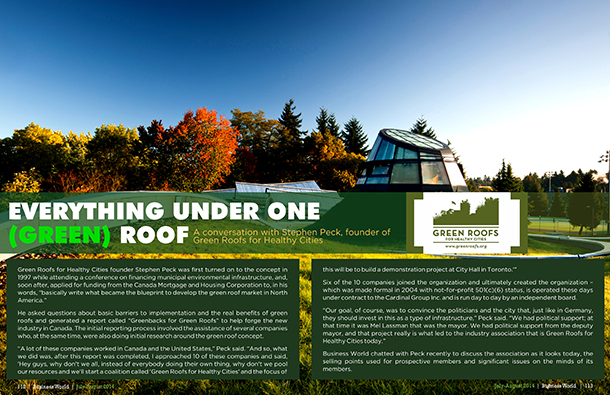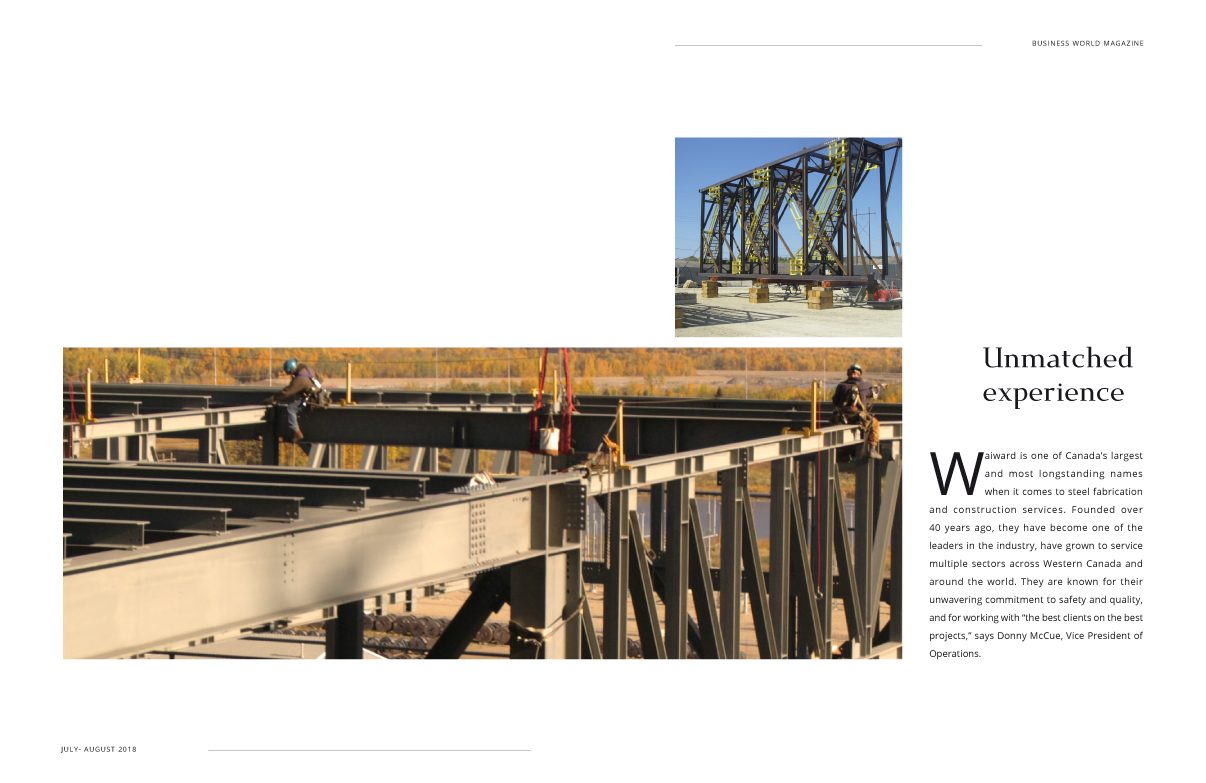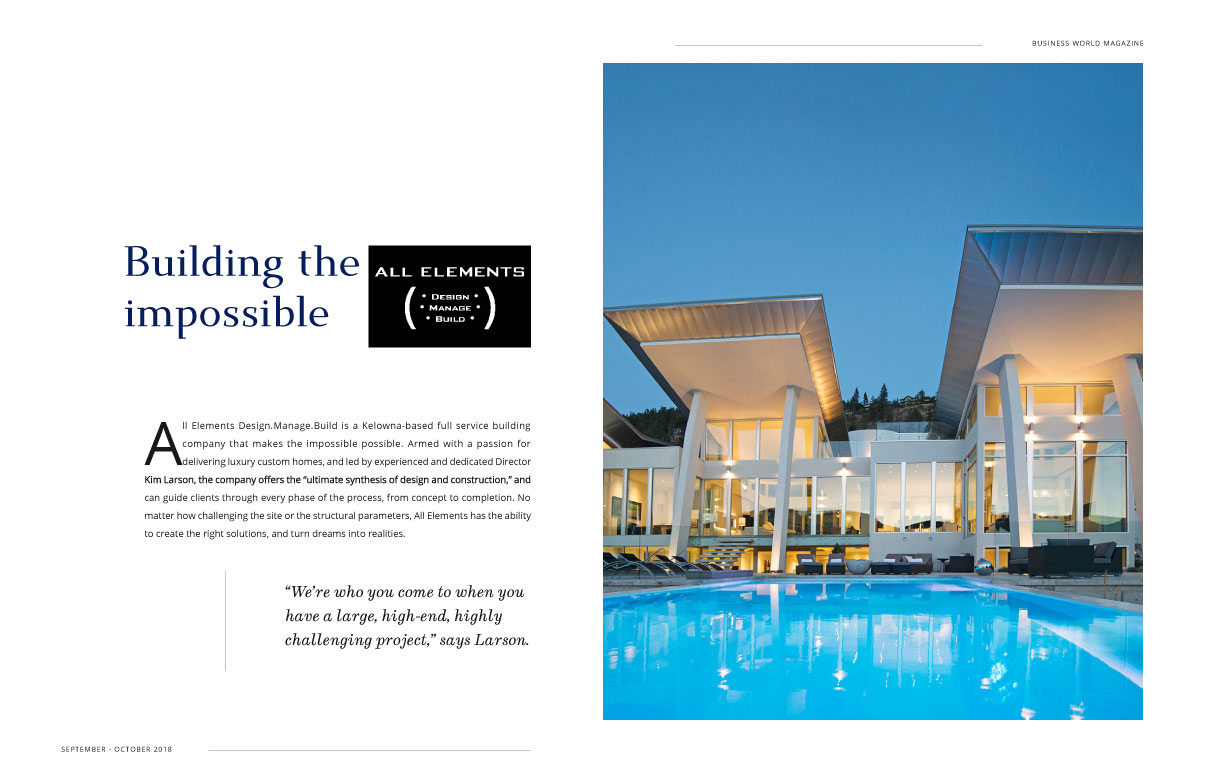
Everything Under One (Green) Roof
A conversation with Steven W. Peck, founder and president of Green Roofs for Healthy Cities
Green Roofs for Healthy Cities founder Steven W. Peck was first turned on to the concept of green roofs in 1997 while attending a conference on financing municipal environmental infrastructure. Soon after, he applied for funding from the Canada Mortgage and Housing Corporation to, in his words, “basically write what became the blueprint to develop the green roof market in North America.â€
He asked questions about basic barriers to implementation and the real scientifically quantifiable benefits of green roofs and generated a report called “Greenbacks for Green Roofs†to help forge the new industry in Canada and the United States. The initial reporting process involved the assistance of several companies who, at the same time, were also doing initial research around the green roof concept.
“A lot of these companies worked in Canada and the United States,†Peck said. “And so after this report was completed, I approached 10 of these companies and said, ‘Hey guys, instead of everybody doing their own thing, why don’t we pool our resources and we’ll start a coalition called ‘Green Roofs for Healthy Cities’ and the focus of this will be to build a demonstration and research project at City Hall in Toronto.’â€
Six of the 10 companies joined and ultimately created the organization – which was made formal in 2004 with not-for-profit 501(c)(6) status, and is operated these days under contract to the Cardinal Group Inc. and is run day to day by an independent board.
The organization is in the midst of preparation for CitiesAlive, a 12th annual green roof and wall conference that will take place in Nashville from Nov. 12-15.
“Our goal, of course, was to convince the politicians and the city bureaucrats that, just like in Germany, they should invest in this as a type of green infrastructure,†Peck said. “We had initial political support from the deputy mayor Case Ootes, and later the new mayor David Miller and deputy mayor Joe Pantalone, and that project really is what led to the industry association that is now Green Roofs for Healthy Cities today.â€
Business World chatted with Peck recently to discuss the association as it looks today, the selling points used for prospective members and significant issues on the minds of its members.
BUSINESS WORLD: Talk to me about your membership. What sort of numbers are you at right now and how has it changed over the last couple of years?
 STEVEN PECK: Our membership is comprised of two groups – there are corporations and then there are individuals. In terms of individuals, one of the barriers that we recognized early on was that there was a lack of training. If you’re going to develop a market, you have to have people that can design, build and maintain these systems. So, we developed what’s called a Green Roof Professional accreditation program, or GRP as we call them. They have to learn best practices in everything from waterproofing and leak detection to project management and maintenance contracting. And we developed a series of training courses, four (and then later three) days of intense training and a multi-disciplinary exam, so individuals can take training and they can become a green roof professional, and they can use that as accreditation behind their name.
BUSINESS WORLD: You have GRP after your name, right?
 PECK: Yes, I’m an accredited green roof professional. We brought a bunch of the leaders together over the course of eight years to develop the curriculum, to go through the rigors of investing and developing a testing protocol that was unbiased and there’s a whole methodology associated with doing this, as well as it cost a lot of money. So, that was one important thing we did – establish professional best practices. Since 2008, a lot of our members have become accredited green roof professionals. We have over 700 accredited green roof professionals and more than 1,000 individual members who are not yet accredited. All told, we have about 2,000 individuals. On the corporate side, we have a wide range of companies that are members. They range from multi-national corporations like Firestone, GAF, and Sika Sarnafil—the big roofing companies, to green roof dedicated companies that manufacture, design and build green roofs such as Columbia Green, Sempergreen, Xero Flor, and Rooflite to name a few. We also have nurseries that are members and who grow green roof and wall plants. If you look at our membership page, you’ll see there’s a wide range of different companies, because green roofs and walls involve a lot of different inputs.
BUSINESS WORLD: How many corporate members do you have?
 PECK: Over 160, which you can find in our online Green Pages: Green Roof and Wall Industry Directory – www.greenroofs.org
BUSINESS WORLD: OK, so it’s much heavier on the individual side.
 PECK: In terms of numbers of members, yes.
BUSINESS WORLD: Are there any other organizations, either in Canada, or elsewhere in North America, that are doing similar kinds of work? Do you compete with anybody? Do you work with anybody?
 PECK: We are very much into partnerships, so we work with a lot of different organizations, where our membership extensively overlaps with their membership. We work, for example, with the American Society of Landscape Architects. Collaboratively, we work with the U.S. Green Building Council and the Living Building Challenge. We’ve done work with them. We also work also with environmental groups such as American Rivers and the National Resources Defense Council because our green roof and wall products deliver many tangible environmental benefits. The environmental groups work with us, because we’re trying to manage stormwater, reduce the urban heat island, grow food, clean the air and provide additional space, and preserve biodiversity. Our products contribute directly to those goals. We work with industries and associations and environmental groups in a variety of different ways. Globally, there are green roof and wall industry associations in more than 18 countries, and they are members of the World Green Infrastructure Network, which is meeting in Sydney Australia this October7-9, 2014.
BUSINESS WORLD: You mentioned all those groups you work with, and you can correct me if I’m wrong, but it seems like more people are paying attention to these sorts of factors these days. People are worried about sustainability and green building and everything like that, more so than back in ’97 like you said when very few people had even heard of the term ‘green roof’, let alone knew what it meant. Do you agree and is this a good time to be doing this? When more people seem interested in what you’re doing than 10 years ago?
 PECK: I think we’ve made a lot of progress but we have a long- way to go. Ultimately we need to build regenerative or restorative buildings, ones that give back to the environment, the occupants and community more than they take. Green roofs and walls are an important and growing component of restorative buildings. Since we started collecting statistics, which was in 2004, we have completed an annual market survey of our members. We estimate that we built a hundred million square feet of green roofs in North America in ten years, since 2004. Now the value of those green roofs probably ranges anywhere from fifteen to thirty dollars per square foot, depending on the type of roof, the depth, and a whole bunch of factors that are too complicated to get into, but there’s a range. It’s not like a light bulb that has a certain cost – the cost varies depending on certain markets and situations, whether it’s a retrofit – there’s a whole bunch of factors that affect cost, but just say from $15-30 per square foot. By 2022, our goal is to put a billion square feet – an additional billion on the roofs of North America. It seems like a lot, but that only represents about 2 percent, roughly, of the total technical potential for green roof applications in North America.  For green walls, the opportunities are even greater and the industry is also growing quickly.
BUSINESS WORLD: There’s a lot of ground to cover.
 PECK: There’s a lot of wasted roof and wall space out there.
BUSINESS WORLD: When you propose membership, either to individuals or corporate entities, what are your main selling points? What are you telling them is your value proposition? Or why they should be involved?
 PECK: Our value proposition has three elements to it in terms of membership. One is that by becoming a member of Green Roofs for Healthy Cities, you support our goal to grow the market. And, we grow the market by doing communication work, like this interview with you. We grow the market by doing advocacy. So, we have a program where we work with local governments to develop policies that support green roof and wall installation, because there are a lot of public benefits that come with green roofs and walls. By becoming a member, you help us build our capacity to grow the market and we all want to grow markets, right? Everybody’s interested in that. Secondly, as a member, you receive the promotional benefit that comes with being a member of an organization – the web promotion, the leads, the networking, as well as the opportunity to work on things like standards development and so forth. And finally, our members receive preferential rates when we have a trade show or conference, or we provide them with discounted advertising in our Living Architecture Monitor magazine, or whatever it may be, they receive a discount. So there’s a big picture, grow the market, branding and marketing and financial incentives for members.
BUSINESS WORLD: Now, I talk to a fair amount of associations in a number of different businesses and most of them have a fundamental core that they say, “this is what we do well†– we’re an educational group, we’re an advocacy group, we do this, we do that – that’s what they plant their flag in the ground for and that’s what their based about. Do you consider yourself an educational group? You just mentioned advocacy, is that something you feel is your strongpoint? Is it something else?
 PECK: I wouldn’t say we do one thing only – I think we punch above our weight class for the size of our organization. Education is really a big part of what we do, because all of the green roof professionals have to do continuing education credits to maintain their standing. The actual industry is evolving very quickly. There’s new science coming out, so we also work with scientists – that’s the other group we work closely with. We’re a very science-based organization, so we encourage science. We have a whole track on science at our conference. We have a research committee. We have an academic, peer-reviewed green roof and wall journal called the Journal of Living Architecture. We facilitate scientific research. We try to direct it to the extent possible, because science is largely about performance. Science is what tells us how much stormwater is that green roof or wall holding. What are the air quality benefits? How much energy am I saving in my building? Science is really important to us, so we work with science and the science generates data that we can then turn into educational programming and our educational programming is what facilitates the advocacy work that we do. So, it’s all interrelated. Science is really critical, because one of the barriers that we identified twelve years ago was lack of independent scientific data on performance, and that’s been a fundamental pillar of the development of our industry – using and engaging the scientific community. Now, there are dedicated green roof research facilities all over North America doing research.
BUSINESS WORLD: Talk to me about the issues that come to your desk, the ones that membership is concerned about, that they want you to pay attention to, and maybe advocate for. What is the membership talking about these days?
 PECK: Obviously, we’re very interested in developing the market. We have a number of local governments that have implemented either a requirement for green roof, so far, Toronto, for example, has a green roof bylaw, where all new buildings over a certain size, I think it’s 4,000 square meters of floor space, have to have a green roof on them. And then we have a whole range of policies that governments can put into place that can help reduce the costs, because it’s more expensive to put on a green roof than a traditional roof. And when you’re re-roofing, it’s obviously more expensive, so because there are many public benefits, there’s a rationale for government to say, ‘OK, don’t put that black roof on when you re-roof the building. Put a green roof on, and we’re going to help you out by reducing your taxes or providing a direct financial incentive.’ So, New York City has a tax incentive, for example, for commercial buildings, where they can reduce the taxes payable if they put a green roof on. This type of investment is a great value proposition for tax payers. With a modest incentive of $7 to $10 per square foot, tax payers are able leverage the private roof space, they leverage the investment, and end up with multiple public benefits, where once there was only heat and ugliness. The private building owner also wins, with longer lasting waterproofing, reduced energy costs and a host of other potential benefits.
We’re working to expand direct policies and incentives beyond the 30-55 cities we have on board. Right now, we’re trying to expand those tools through advocacy and communication and our local market development symposia, which engage policy makers, designers and manufacturers. That’s probably one of the top priorities that we have, that our members would like to see us do – build that market, grow that market. That’s what we’re going to have to do if we’re going to get to that billion square feet by 2022.
BUSINESS WORLD: If we were to revisit this conversation in five years, other than working toward your billion, what do you hope changes? Where do you see the organization in five years?
 PECK: I think it would be nice to have the organization grow along with the industry. During the great recession, we continued to grow as an organization and we continued to have conferences and we continued to advance the market. And, our industry grew, even during the recession. I’d like to see green roof policy in over 100 cities. It would be nice if the senior levels of government could recognize that green roofs are a part of infrastructure. And, when they have an infrastructure investment program, it would be very nice to see governments recognizing that green roofs and walls, and urban forests, and all these green infrastructure technologies have a role to play and should be recognized as infrastructure. And, the funds should be made available to create the jobs and get all of the other benefits that come from them. We need water and energy utilities to recognize that by keeping stormwater on the envelope of a building, it saves energy, reduces the urban heat island and can reduce flooding. There are shared interests between the water and energy sectors and very little shared programming. That needs to change.
The third thing I would like to see in five years is more big-box developers embracing green roofs and walls. They’ve been a tough market. They’re very cost-conscious, but we’ve made some headway and even Walmart, has recently released a report that shows that green roofs can generate a return on investment.  I’d like to see more big-box retailers embrace living architecture because they cover huge amounts of land. So, if we can get the developers of big-boxes and owners of big-boxes to recognize that, not only do they have an obligation to put green roofs on in terms of the community, there’s also a really good economic argument, we can make more progress here.







